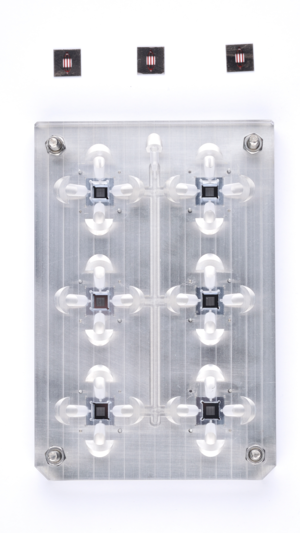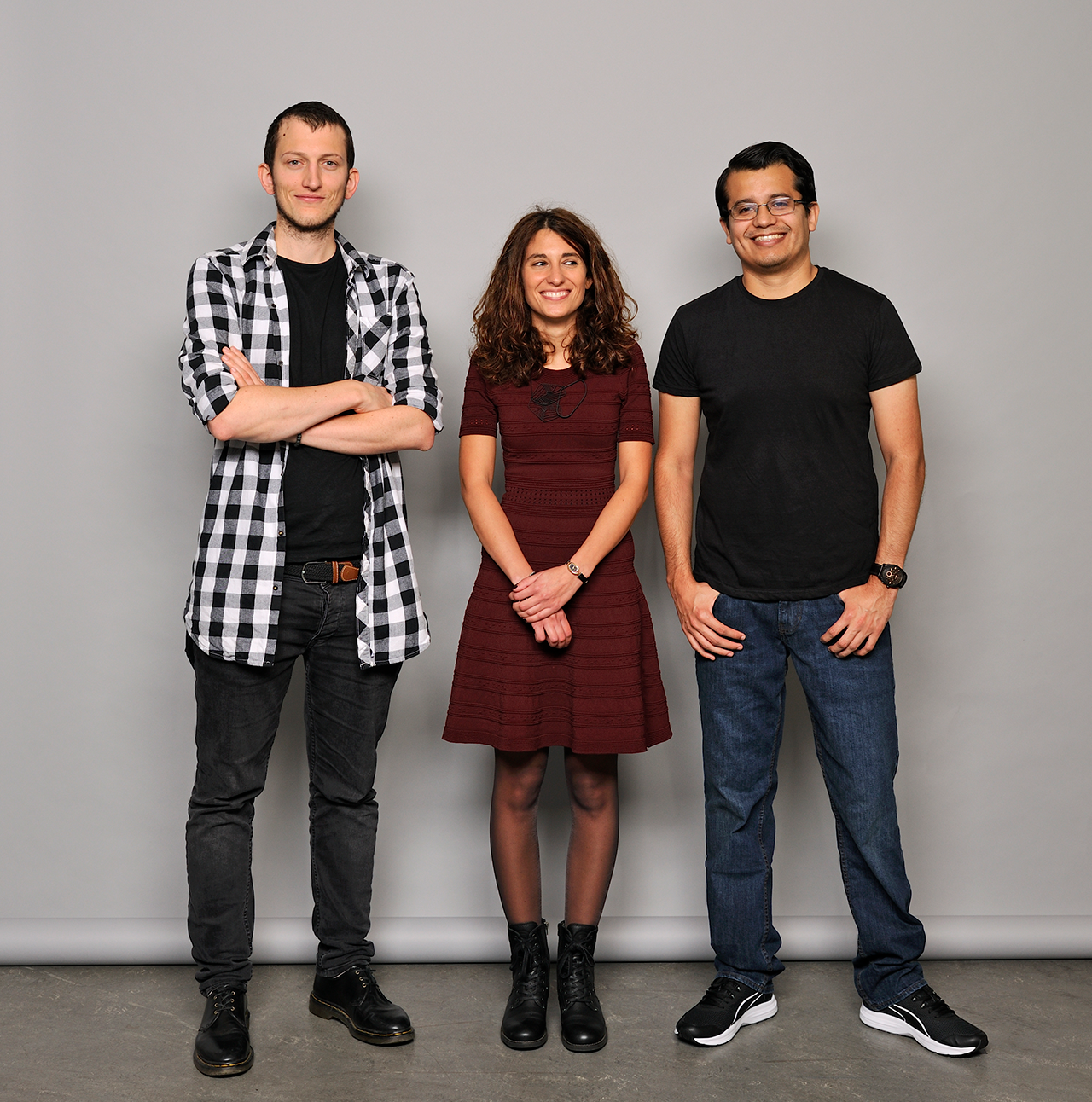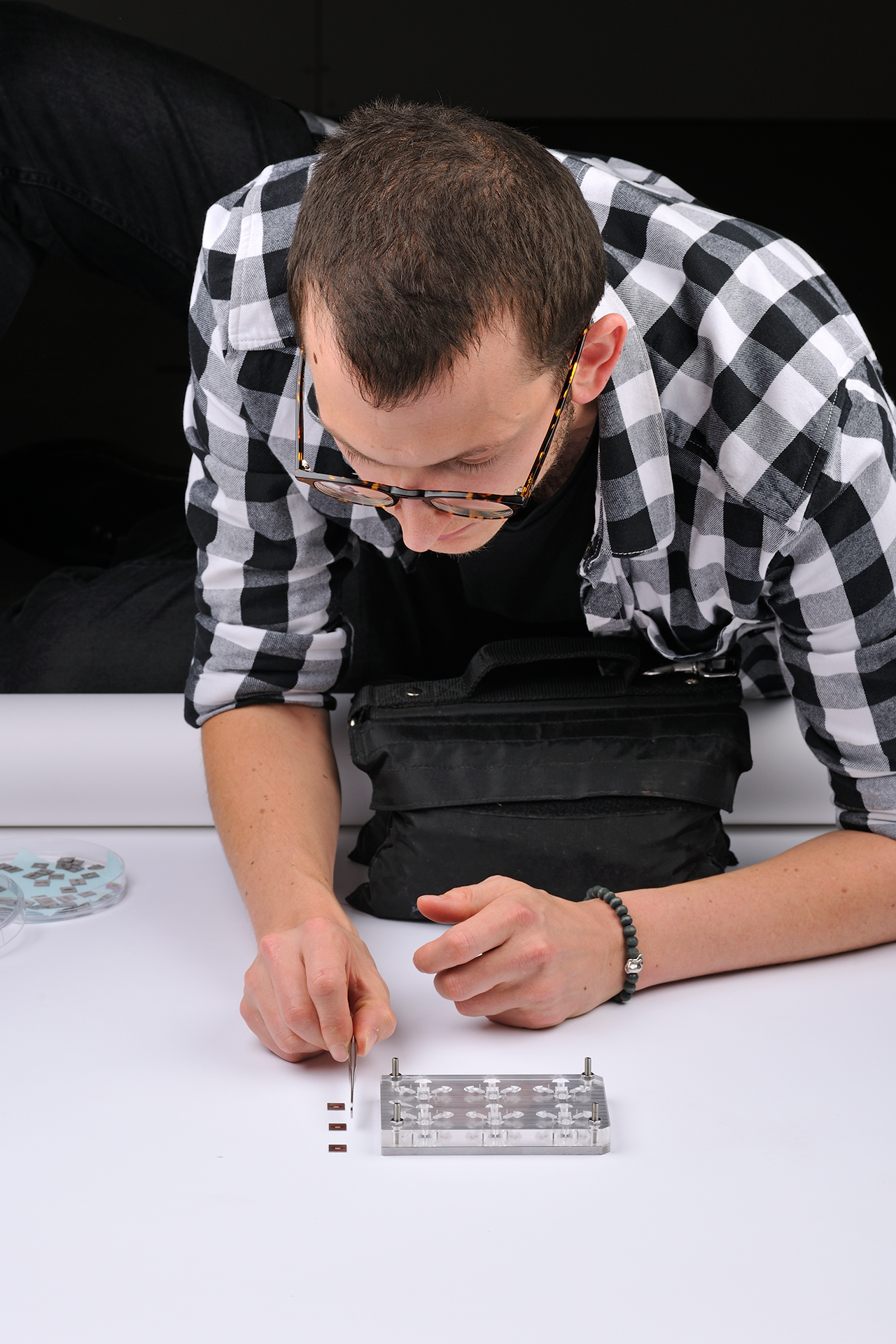From cleanroom to boardroom
Three young researchers from the Else Kooi Laboratory (the TU Delft cleanroom) are doing something different from what most academics in the field of microfabrication would do. Instead of writing a kick-ass publication about their serendipitous discovery in the lab, they are turning it into a start-up. Founders Nikolas Gaio, Cinzia Silvestri and William Solano talk about the future of Organ on Chip, and life outside the cleanroom.
“In the near future, biologists will take a little sample of your skin, turn it into stem cells, and then turn those into heart, lung, gut and muscle cells. These cells can be placed on our chip to create a small model of one of your organs (Organ on Chip). This can be used to see if any new medicine would work for you. This offers huge potential in personalised medicine. We are now testing our technology in a project with the Erasmus Medical Centre in Rotterdam. The aim is to see if we can put a biopsy of a cancer on our chip, not only to personalise the treatment for particular patients but also to find the answers to fundamental questions on cancer biology.”
It’s a next-generation thing
Organ on Chip unites two scientific fields: microfabrication and biology. Biologists are looking for a chip that can mimic the dynamic environment found in the human body, in order to improve the predictivity of their in vitro tests. And, electrical engineers need help from biologists to identify the parameters and features that need to be included in the chips. The communication between these two different habitats is extremely important in order to develop the best Organ on Chip. Cinzia: “It’s not easy to explain our kind of blunt, very technical, product to biologists who like working with living organisms. Over the last year, we’ve become better at it, using illustrations and videos, which show the movement and flow [see box] that they require. We find it easier to work with our peers at the moment – other PhD candidates and post-docs – because they are generally less conservative and are into trying new technology. Organ on Chip really is a next-generation thing.”
It all started from an honest mistake
A little over a year ago, Niko, William and Cinzia were all PhD candidates working on their own research projects in the cleanroom. That is a comfortable glass hub where young engineers share everything about their lives and research at the end of each working day. Evidently, it all started from William’s mistake. William: “I was fabricating a device for my PhD project, and was trying to solve something I had been struggling with for a couple of days. I modified my prototype and immediately thought that it was a useless call. But then, after talking with Niko, we understood we could actually design a brand new device with it.” Being proper PhD candidates they immediately started thinking about the kick ass publication they could write about it. That is, until Cinzia ‘meddled’ her way in. “I was already thinking about life after my PhD, about doing job interviews. However, I wanted to make a difference and I knew that was not going to happen at a big company. So, I convinced them to create a business out of this.”
Out of the lab and into the market
Cinzia got her doctorate in microelectronics last summer, and is now working as a part-time post-doc. For the guys, respectively being in the third and fourth years of their PhD projects, it is a bigger challenge to run a start-up on the side, time-wise at the very least. Niko: “We had to say goodbye to our weekends. Our start-up life doesn’t differ much from life as a PhD candidate.” Cinzia laughs: “We’re already used to being frustrated all the time”. William: “I think the whole process of the start-up has made the device a lot better. As a PhD, you only think about how you can turn a device into a publication. Now we have to think about the real needs of our customers.” Cinzia: “William is our technical guy. Nikolas is our frontman, developing the business, talking with future customers and partners.” Niko: “And Cinzia takes care of the start-up strategies and the funding”.
About the Organ on Chip market
Cinzia: “It’s a young market: most of our competitors are start-ups. Organ on Chip is between research and the market. It is still an open field. Niko: “Our aim is to create a set of chips so as to cover multiple functions and organs. These will be used by biologists with a single user-friendly interface. We are also improving the predictivity of Organ on Chip, by adding better functions, so we can realistically mimic the dynamic conditions of the human body." [see box]
Future
Niko: “In the course of last year, we slowly came to an understanding that being an entrepreneur is not something you can learn from a book. Although Cinzia keeps on buying them.” Cinzia: “We believe in the business and the product. For the first time, we are bringing something from the lab to the market. We dreamt it up as a result of William’s honest mistake, and now the product is virtually on the shelf. Not many researchers get to be that lucky. Also, society will really be able to see the value of it when it all leads to better medicines. Then at least, for once, my mother will be able to understand what I am doing”.

Organ on Chip - Definition
An Organ on Chip is a small device, a chip with human cells on it. This combination provides an artificial model that can replicate a specific organ – or a specific function – of the human body. It is a new way of testing medicines and has the potential of making animal testing redundant in the future.
Is it really an organ on a chip?
Niko: “Sometimes, when we show our chip to people, they say something like: ‘where’s the heart?’ You might expect a tiny piece of heart on a chip. In reality, an Organ on Chip is a rather blunt 2D device, that you have to observe through a microscope.” William: “Also, it’s not exactly a whole organ that we’re mimicking. It’s a small and vital unit of an organ. At the moment, biologists use static in vitro techniques to test new medicines. They place human cells in a plastic well and they see what happens when they add the drugs. It’s not that hard to imagine that the situation in that plastic container is different from what goes on in a living body. Hence, the current need for animal testing. So, just to illustrate the benefits of an Organ on Chip, we include movement and flow in our chip. Because a heart beats and lungs contract and expand. These movements are essential in medicine testing. We try to make these tests predictive enough, as close as possible to the human body.”

